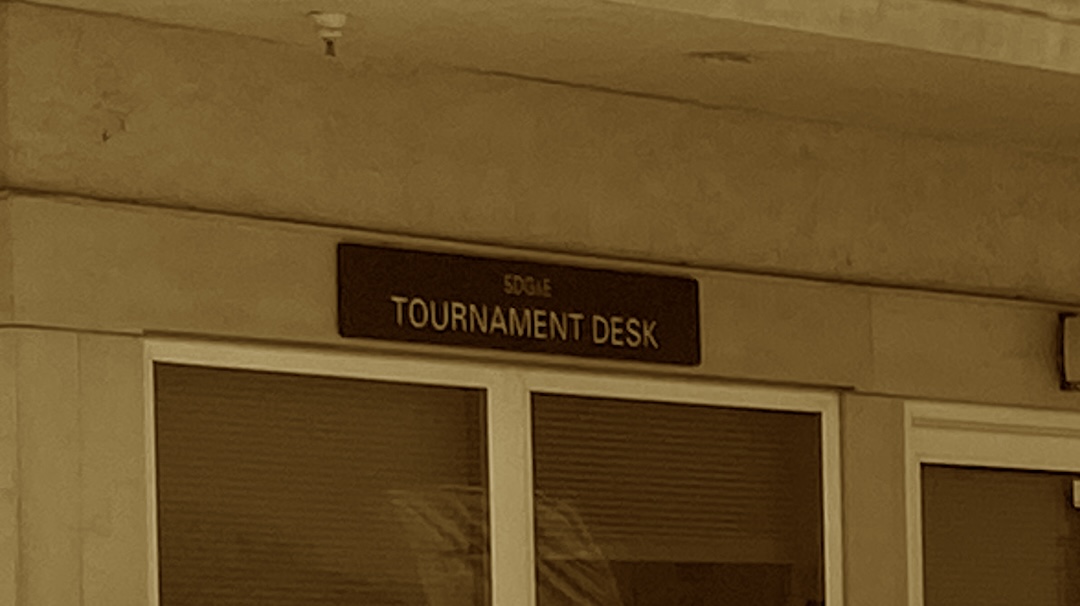I will compete in the NTRP National Championships in San Diego this weekend. That means that this morning is my last chance to grouse about the format of play for a while. If I don’t get the results I want at the event this year, no one can say this post is just a case of sour grapes.
Regardless of how the event turns out, I will continue to believe that the best way for the USTA to bolster the event’s credibility and prestige is to extend the playing format to include at least two full sets with advantage scoring. National Championships should not be decided by shortened formats unless it rains… a lot.
To be transparent, I did not pursue or accumulate the rankings points necessary to earn my own way to the Championships this year. I will be competing as the invited doubles partner of a good friend. In fact, the only way I anticipate playing in this tournament in the future is in doubles with someone else who invites me to play off their own endorsement. I have zero intention of playing singles at the NTRP National Championships in the future.
My absence of motivation and low engagement regarding the Level 1 NTRP Championships is a visceral reaction to the format. I would rather play a Level 1 Senior Open Age Group National Championship tournament for the same approximate cost and a slight increase in time. For example, I played six matches across four days at the National Senior Women’s Clay Court Championships a couple of weeks ago. While I didn’t get the results I wanted at that tournament, I spent a lot of time on the court.
When I answer the USTA’s post-tournament survey rating the value of an event, my answer is largely driven by the quantity and quality of the matches I played. My response is also informed to a lesser extent by the amenities and overall experience. The National Senior Women’s Clay Court Championships was 5 stars across the board.
I already know that I will play at most four short-set matches at the NTRP National Championships this weekend. There is also a chance that my partner and I could only get four matches if we do not perform to our expectations. Additionally, withdrawals are a chronic problem at this tournament, which would potentially translate into even less tennis.
What is the Nominal Length of a Fast4 Match?
I don’t have good data on the nominal length of a Short Set / Fast4 match. Based on some of the past scheduling challenges at the prior NTRP National Championships, I don’t think it is unfair to speculate that the tournament organizers might not exactly have a handle on it, either.
The USTA publishes a set of “Garman” tables to aid tournament scheduling. Despite the fact that the 2023 USTA Friend at Court claims that a publication on the Garman System is available from usta.com, I cannot find what appears to be an up-to-date version on the site. (I think that maybe it is because my Serve Tennis account is not yet associated with a registered organization.)
Fortunately, USTA Georgia published a “Short Set” version of the Garman Tables in 2010. In that document, the maximum average length of a short set match is set at 69 minutes. Those same tables allow a tournament organizer to schedule matches based on an average duration of as little as 34 minutes. That seems ridiculously short.
An alternate way to determine how long the USTA thinks an average short set match will take would be to reverse engineer it from the match times scheduled in the draws. I do not have the time to comb through all the event data for that purpose manually. However, this is a good time to mention that it would be really helpful if the schedule tab on the tournament pages returned useful data or, for that matter, any data. Someone who clicks on the schedule tab would ordinarily expect the scheduled matches to be displayed, but that feature does not seem to be implemented yet.
How Much Tennis Will I Play This Weekend?
If my doubles partner and I play our maximum of four matches, and those matches average the 69-minute “long” duration for the short set format projected by USTA Georgia, I will play a total of 4 hours and 36 minutes of tennis this weekend.
To contrast that with the Senior National Clay Court Championships in Houston a couple of weeks ago, I played two singles matches, which each lasted more than 3.5 hours. That is 7 hours of court time from those two matches alone. I also played two additional singles matches and two doubles. Conservatively, I was on the court for at least 13 hours over the course of that tournament.
As an additional point of contrast, my prospects for competing in local league play this weekend are unusually light. Only three of my league teams have matches scheduled this weekend while I am playing in the tournament. Those match durations tend to run somewhere around 90 minutes long. That would put me on the court for 4.5 hours at home had I passed up the opportunity to play in San Diego. No airplane ticket, hotel room, or vacation days are required.
It’s Not Enough
This is why I have consistently maintained that the NTRP National Championships are unlikely to ever be high on my priority list. The tournament simply doesn’t deliver enough tennis to justify the cost and time that it takes to compete at the event. I travel to tournaments to play tennis rather than as a tourist.
Additionally, the shortened format is not appropriate for a National Championship tournament where the players are not expected to know each other. It takes time to figure out the tactics and strategies required to win a competitive tennis match against unknown opponents. There is simply not enough time to explore tactical options when playing Fast4. As I have previously observed, I am more accepting of shorter formats in the context of local-level tournaments. No one bought a plane ticket to be there.
Additionally, the shortened tie-break game that the USTA uses at the event is fundamentally flawed. “Tie-Break: Short Set vs Fast4” highlights the issues so I won’t rehash them here. A quick fix is using a standard 7-point Coman tie-break game. There are too many ambiguities in the “First to 5” tie-breaker, which is a disservice to both the players as well as the officials.
Despite all this, I am looking forward to competing in the tournament with my friend this weekend. It’s just not an event that I anticipate being inspired to pursue on my own unless there is a significant future format change. Until then, I can take it or leave it. There are simply other USTA tournaments to play that return considerably more value.
- Friend at Court: The Handbook of Tennis Rules and Regulations, USTA, 2023
- USTA Georgia “Garmin Tables”Short Set” Garman Tables, dated April 15, 2010.




One could also argue that the fast 4 is preventing the highest caliber players from coming because of the reasons you stated. I highly doubt I’ve met the best players in the nation from all sections — just the ones that thought it would be cool to go and had the time and money to do it. I only spent a grand total of 3 hours on the court for the entire doubles tourney – I just added it up on my watch. That’s not worth it. But you don’t know how big the round robins will be until you entire so you’re rolling the dice when you sign up. I will say I do appreciate the mental challenge of the fast 4 format. Never have I felt so much pressure to hold serve and win every point. There just isn’t time to lose momentum for even a moment. But the cons of the format definitely outweigh the pros by a long shot. It’s nationals – let us play it out properly. Or at least the way we’re used to with full sets and a 10-point breaker for the 3rd.
I agree with you – as someone who only got 3 matches this weekend, I spent a total of 3 hours on the court (thanks to the Jenna’s for a 90 min match!) The one thing I do like is the mental challenge of the fast 4 format. It’s pressure like a regular match can’t match. But I don’t think that outweighs the cons – I don’t think the best players in each section are coming because they feel like you. And if we’re playing regular scoring to get to this tourney, it seems weird to switch the format for the national tourney.
It appears you are at one end of the recreational player spectrum, the end that wants lots of court time and is willing to take time off to play tournaments that offer this (like the age based nationals). I’d place myself at the other end of this spectrum. I play the fast 4 format tournaments because they are done in one day on the weekend. From my perspective, having to identify winning tactics vs a new opponent in the shorter format is a feature not a bug. I also find there is considerably more pressure to hold serve and as such, the mental aspect of the game is heightened. To me, fast 4 matches are a nice change of pace from traditional match formats. I see your point about the format not guaranteeing enough court time at nationals to justify the travel but I also don’t think it’s fair to the players to change the format from how they played locally to qualify.
I play fast 4 format, USTA team format (3rd set super TB) and an online league requiring three full sets. I enjoy them all because each requires slightly different mental and physical preparation and execution. The match format variety provides spice to my tennis life.